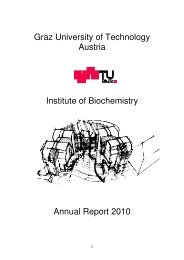Staff Members of the Institute of Biochemistry, TU Graz http://www ...
Staff Members of the Institute of Biochemistry, TU Graz http://www ...
Staff Members of the Institute of Biochemistry, TU Graz http://www ...
You also want an ePaper? Increase the reach of your titles
YUMPU automatically turns print PDFs into web optimized ePapers that Google loves.
demonstrated that PtdEtn formed in all three organelles can be supplied to peroxisomes<br />
and to <strong>the</strong> plasma membrane. The fatty acid composition <strong>of</strong> peroxisomal and plasma<br />
membrane phospholipids was mostly influenced by <strong>the</strong> available pool <strong>of</strong> total species<br />
syn<strong>the</strong>sized, although a certain balancing effect was observed regarding <strong>the</strong> assembly <strong>of</strong><br />
PtdEtn species into <strong>the</strong> two target compartments. We assume that <strong>the</strong> phospholipid<br />
composition <strong>of</strong> peroxisomes and <strong>the</strong> plasma membrane is mainly affected by <strong>the</strong><br />
syn<strong>the</strong>sis <strong>of</strong> <strong>the</strong> respective components and subject to equilibrium, and to a lesser<br />
extent affected by specific transport and assembly processes. Organelle association and<br />
membrane contact between organelles may be a relevant mechanism for lipid transport<br />
between organelles, but components governing this process and related events have to<br />
be studied in future investigations.<br />
Neutral lipid storage in lipid particles and mobilization<br />
Yeast cells have <strong>the</strong> ability to store neutral lipids TAG (triacylglycerols) and SE<br />
(steryl esters) in subcellular structures named lipid particles/droplets. Upon requirement,<br />
TAG and SE can be mobilized and serve as building blocks for membrane biosyn<strong>the</strong>sis.<br />
In an ongoing project in our laboratory, we investigate and characterize enzymatic steps<br />
which lead to <strong>the</strong> storage <strong>of</strong> TAG and SE and at <strong>the</strong> same time to <strong>the</strong> biogenesis <strong>of</strong> lipid<br />
particles. Moreover, we study processes involved in <strong>the</strong> mobilization <strong>of</strong> TAG and SE<br />
depots.<br />
In <strong>the</strong> yeast, <strong>the</strong> SE synthases Are1p and Are2p, and <strong>the</strong> TAG synthases Dga1p<br />
and Lro1p contribute to <strong>the</strong> formation <strong>of</strong> lipid depots (Figure 2). We have to distinguish<br />
between de novo formation <strong>of</strong> lipid particles on one hand and incorporation <strong>of</strong> neutral<br />
lipids into preformed lipid particles on <strong>the</strong> o<strong>the</strong>r hand. Using a dga1 lro1 are1 are2<br />
quadruple mutant and <strong>the</strong> related set <strong>of</strong> triple mutants we performed cell biological and<br />
Figure 2: Pathways <strong>of</strong> triacylglycerol (TAG) and steryl ester (SE) metabolism in <strong>the</strong><br />
yeast. DAG: diacylglycerol; FFA: free fatty acids; PL: phospholipid.<br />
17














